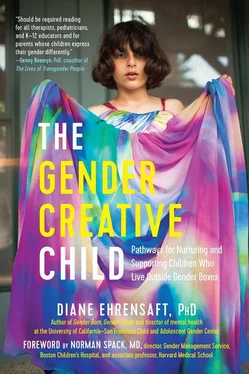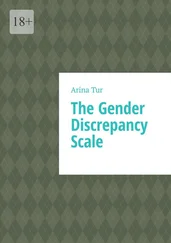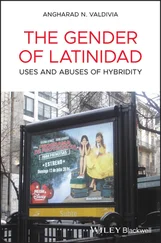Since I completed Gender Born, Gender Made , I’ve traveled many miles in my journey as a gender specialist. I became the director of mental health at the Child and Adolescent Gender Center (CAGC), the attending psychologist at the CAGC gender clinic at the University of California, San Francisco, Benioff Children’s Hospital, and the ever-evolving therapist of an ever-growing group of gender creative children and their families. I continue to lecture, train, write, advocate, build a professional community, and conduct research on the lives of these people who have been my greatest teachers. Using composite portraits of the children and families I have had the honor to work with, each of the following chapters in The Gender Creative Child is designed to be its own independent learning module about psychological, social, and community issues as we get in clearer focus the infinite variety and rapidly growing population of gender creative children across the globe. And at the end, we will ask what more we need to learn.
In Chapter 2, “What’s Your Gender?,” I will lay out a framework for thinking about the evolution of each child’s gender, an evolution that can result, like snowflakes, in an infinite variety of shapes and forms, with no two exactly alike. Chapter 3, “The Gender Spread: Apples, Oranges, and Fruit Salad,” will then organize those infinite shapes into some identifiable groupings—the children who are clear that the sex listed on their birth certificate does not match the gender they know themselves to be; the children whose gender matches that assigned sex but who do not express their gender in ways that conform to social norms, expectations, prescriptions, or proscriptions; and the children who either are a mix, live in the middle, or repudiate any categories of gender altogether. Chapter 4, “When It’s Gender and Something Else or Something Else,” looks at the accompanying psychological factors that often show up alongside gender creativity and then differentiates them from the psychological factors in situations where gender variance may be a symptom or solution to some underlying nongender stressor rather than a core expression of a gender self. In Chapter 5, “It Takes a Gender Creative Parent to Negotiate the Gender Maze,” we both honor and lay bare the rugged terrain of raising a gender-nonconforming child, both when social supports are there, and when they are not. Chapter 6, “If Gender Is Expansive, Wherefore a Shrink?,” maps out the mental health field as we know it now, with particular attention to the gender affirmative model of clinical practice that is advocated in this book. In Chapter 7, “Do We Want a Doctor in the House?,” we explore medical options for gender-nonconforming youth, paying close attention to the cultural context, the psychological complexities, and the quality-of-life implications for both children and parents with each of these interventions. Chapter 8, “Into the Streets/Onto the Screens,” addresses the mobilization of gender activist forces in schools and in communities coupled with the profound impact of the Internet and social media on gender-nonconforming youth across the globe. Even in the most remote of places where they might believe themselves to be the only one in the world, social media affords them the opportunity to experience a mirror of themselves, to find each other in a virtual community, and to discover a name and discourse for what they are experiencing. In Chapter 9, “What’s Left to Learn?,” I share the unexpected epiphanies I had while writing this book, highlighting what I learned along the way, and shining a light on the transformations in the making or yet to come in solidifying gender infinity in our society.
Just as I was finishing writing the first draft of this chapter, I got a call from a gynecologist in my area, someone I did not know. She got my name from another local doctor. Distraught, she sounded close to tears. A father had just brought in his eighteen-year-old to see her. This young person was assigned female at birth but knew from age seven that he was a boy, and had only recently announced to his family that he was transgender. The father wanted the gynecologist to fix him—discover the medical problem and make him be a girl. If he didn’t get fixed, he was not going to be allowed to go to the prestigious university he was scheduled to leave for in four weeks. He would have to stay home and go to a local community college until he was cured. The gynecologist handled the situation beautifully, refusing to do a medical exam and allowing the youth to meet privately with her to express himself about his gender, offering an accepting and empathic ear. I and the gynecologist shared our grief that this young person, eager to start his university studies in his newly affirmed gender, had to suffer this setback. We came up with some possible solutions to support him and to work with his family. We both had fleeting fantasies of paying his college tuition so he could attend. As we spoke to each other on the phone, I could only wish that I was at the end rather than the beginning of this book when the call came in, so that this father might have a resource to help him recognize that his child was in no way gender disordered; rather, gender creative. Yet, I hope that there will be many other mothers and fathers who will benefit from hearing the possibilities for gender creativity and the tremendous gift we can give all of our children if we just let them be who they are. So to that end, I now invite you to travel with me through the pages of The Gender Creative Child .
CHAPTER TWO
What’s Your Gender? From Boxes to Spectrums to Webs to Gender Infinity
There’s tremendous untapped creative power in children’s diversification of the gender landscape.
—Kathy Witterick, mother of Storm
On August 24, 2014, the “Women’s Fashion” edition of T: The New York Times Style Magazine came out. Because of either their extreme prices or outlandish styles, it is hard to imagine anyone dressing for everyday life in any of the clothes. But what struck me was the gender fluidity. Men wore scoop-neck tops and flowing scarves historically the purview of French ingenues or 1950s bombshells. Women wore baggy overcoats and men’s trousers, the elegant kind my grandfather the tailor would sew for my brothers and my boy cousins. And really, who knew whether any of these models were men or women, or just posing as such?
Four days before that, the San Francisco Chronicle published a front-page article about Mills College, one of the few remaining women’s colleges in the United States. The headline: MILLS COLLEGE SPELLS OUT WHAT IT MEANS TO BE FEMALE. Well, I thought, I’m glad somebody’s figured it out . What did I learn? Mills College is the only single-sex college campus that allows applicants to identify themselves by their affirmed gender on the application, with no reference to their natal sex—if it is female, they’re a candidate. Included as eligible undergraduate applicants to the all-women’s college: those not assigned a female sex at birth but who identify as female, as well as those assigned a female sex at birth but who do not fit into the gender binary. Excluded as applicants: people assigned a female sex at birth but who have become legally male before applying, or those assigned male sex at birth but who are questioning. Allowed to stay and complete their undergraduate studies: students who enrolled as female but transitioned to male after entrance. In fact, the incoming student body president is a transgender man. Some still object to the new written gender policy as too binary, given the requirement that only women need apply, either by birth assignment or affirmed identity, leaving no room for gender-neutral applicants who are assigned males. [13]But it is still a monumental shift toward gender inclusiveness and a far cry from the 1990 eruption on the Mills College campus when trustees voted to include men in the college to increase revenue, setting off an uproar “Better Dead than Coed” that resulted in the rescinding of that vote and reinstatement as an all-women’s college. As the female students protested, no one in that decade could have had any inkling of the effects of the next twenty-five years on Mills College’s gender sensitivities, as the bedrock of gender morphed into moving boulders.
Читать дальше












